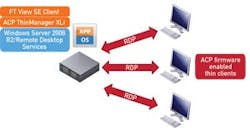Virtualization Technology Yields Hard Number Savings
Gallus BioPharmaceuticals and Malisko Engineering deployed a new Rockwell Automation PlantPAx process automation system using VMware ESXi for virtualization and Microsoft Windows Terminal Server with ACP ThinManager for thin client implementation.
Figure 3. A recent pharmaceutical project used Microsoft Windows Terminal Server with ACP ThinManager to simplify and speed thin client implementation. (Diagram courtesy of Rockwell Automation.)
According to Steve Schneebeli, the lead systems engineer at Malisko, these technologies resulted in server and client hardware savings, a reduced controller footprint and reduced energy usage. Specifically, their customer was able to:- Save money and space by replacing six non-virtualized servers with two virtual servers. About $20,000 was saved in server hardware costs.
- Save 33% in hardware costs by using thin instead of thick clients.
- Cut energy consumption by approximately 55% by reducing the number of servers, and by using thin instead of thick clients.
- Cut validation costs by 75%.
- Reduce disaster recovery time by 6 hours.
"Utilizing virtualization greatly reduces server disaster recovery time, and thin client technology allows for replacement of thin client hardware in a fraction of the time," notes Schneebeli.
"Rockwell licensing is software-based and is independent of thick- or thin-based architectures, so moving to thin clients didn't produce savings in licensing costs. But the use of virtualization and thin-client based architectures allows more efficient designs, which can reduce the number of required software licenses," says Schneebeli.
"An example would be the ability to share an image between multiple engineers with virtualization, or to create "follow-me" thin clients that follow a single operator from thin client to thin client in a large plant, instead of creating a thick client at each physical location," explains Schneebeli.
"We see private cloud technologies becoming commonplace in the industrial space—providing redundancy, project backup and functionality restoration—while adding the benefit of reduced hardware costs. Private clouds will provide virtual server redundancy through the use of multiple physical servers where multiple virtual server images can be installed. If one physical server fails, the virtual images will not notice the server failure, since the physical server resources are pooled together in the private cloud," foresees Schneebeli.
"Private clouds will provide more robust security measures and policies such as read-only functionality to raise the comfort level of companies concerned with exposing their manufacturing automation systems to the outside world," concludes Schneebeli.

Leaders relevant to this article:





